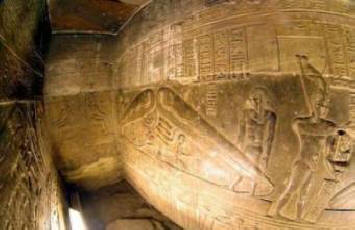 A photo from open sources
A photo from open sources
In the summer of 1977, a results report was published. Content research 81 graves on the Black Sea coast Bulgaria. All of them belonged to about 4500 BC, to times when technological advances are basically limited to wooden or adobe huts, various stone tools and ceramic pots.
This cemetery made such an impression on its constituent a description of an archaeologist professor at the University of California at Los Angeles of Lithuanian descent Maria Gimbutas that she even resorted to terminology rarely found in the academic language. “Graves,” she wrote, “are sensational in their extraordinary wealth of gold, copper, marble, obsidian, flint, various semiprecious stones and Aegean sinks, as well as evidence of technological advances, including graphite and gilded ceramics. “Once again archaeological the discovery turned into a flair of historical romance – after all, speech could go about a lost civilization, much ahead of development a time that once flourished in the heart of Europe.
It seems that the “people of Karanovo” lived an idyllic life, characterized by prosperity and equality at the same time time (only in five of the graves no rich utensils were found), independently and distinctly from the creators of megaliths on the one hand, and new farmers and urban planners of the Middle East – on the other. The most remarkable in this sense is the grave of a rich man, buried with a whole stock of gold jewelry – three gold necklaces, six massive gold bracelets (three for each hand), two rectangular earrings of fine work of gold wire, six small gold hair clips and various gold discs that were once sewn to clothes. At the shoulder of the buried lay, according to the description of Mary Gimbutas, a stone ax of excellent work with a handle in gold and the other side was a copper spear whose shaft was also in a gold frame.
In recent years, such amazing discoveries have literally followed. one by one. In early 1977, the director of the London Institute archaeometallurgical studies professor Beno Rotenberg announced the discovery in Israel and Spain of copper mines and smelters, relating to the fourth millennium BC. This is a discovery delayed the previously established time of the first copper copies as much as two thousand years ago, meant, he said, “a complete revolution in our understanding of ancient technology mining. “Meanwhile, archaeologists Andrian Boschier and Pierre Beaumont found in southern Africa traces of development of ocher, derogatory these Middle Eastern and European finds.
Carbon studies in Groningen University in Holland, showed that one of the mining complexes were actively used in the period from 26 to 20 millennium AD, and began to act, perhaps even earlier than 40,000 years before AD! The age of 35-50 thousand years established for bones with notches found elsewhere in the extraction, “indicates the ability of a person to count this long period. ” in their own discoveries, scientists were forced to conclude that “the true time to start field development in Swaziland is approximately 80-70 millennium BC. “Such discoveries should significantly affect two groups of scientists researching prehistoric era that entrenched in different camps. With one orthodox archaeologists brought up in those days when to believe in anything other than gradual spread civilizations from the Middle East in the years following the invention of writing around 3000 BC was considered heresy.
For this ever-shrinking team, and even for those who changed his views and agrees that development processes civilizations walked independently in several different centers, any very ancient wonders like writing boards or lightning rods unconditionally the fruits of either fraud or false interpretations or errors in determining the age of finds.
On the other side are extravagant writers who have the tendency to believe that any amazing antiquity, whether sculptural image of a giant head, a pyramid or even the wheel is an example of sudden intervention and lost super-advanced technology that existed in some indefinite ancient time. For both groups, new discoveries are instructive a reminder of what miracles a person can achieve on their own without resorting to the help of wandering Egyptian priests or creatures from outer space.
One example is ancient use. electricity. In June 1936 during a time near Baghdad earthwork railway builders came across an ancient a tomb covered with a stone slab. Over the next two months iraqi the whole department was removed from the department of antiquities objects related to the Parsi period (248 BC – 226 years. AD) with a total number of about 613 – beads, clay figures, various bricks, etc. But among these finds was an item of unusual interest – a copper cylinder with an iron the pivot which is German archaeologist Wilhelm Koenig, who led at that time the laboratory of the Iraq Museum, with a high degree of probability identified as a primitive electric battery.
Returning to Germany, to the Berlin Museum, he compared the find with other Iraqi cylinders, rods and asphalt plugs, which all bore corrosion, as if corroded by acid, and several thinner iron and bronze rods, found with them. He concluded that the design used to increase voltage (as many as ten batteries connected in parallel), with the immediate goal of generating current for plating fine local gilded and silver plated jewelry.
This remarkable conclusion attracted very little attention. for reasons that the curator of the London Museum of Science is a chemist and physicist Walter Winton explained when he arrived in Baghdad in 1962 for the reorganization of the Iraq Museum, moving into new buildings. “Tell any physicist,” he remarked, “that electric current used 15 centuries before Galvani and his frog legs, and you will hear in reply: “Nonsense! A ridiculous idea! Impossible!” Such there was my own reaction when I first heard about it. I He was extremely suspicious of this. False interpretation of facts hoax, fake, another grinning Piltdown skull. After all, if this were true, then it should have become the greatest news in the history of science! ”
However, when he saw the battery, he immediately recognized it as primitive electric element. Today he says that “not being archaeologist, I immediately darted right in the direction of the simplest scientific decision. I still don’t see what else could it be for be used, and if anyone has any better ideas on this, I was not informed about them. For absolute confirmation of this version lacked some accessories like connecting wires, and I considered it important to publicize my interpretation for so that archaeologists begin to look for them in addition to the usual contained in the burial of familiar objects. Are practical electricity knowledge was so unthinkable at that time? I I am sure that the capabilities of ancient people are significantly underestimated. Perhaps the very idea of the incredibility of this is simply rooted in the minds unbelievers, and arrogant pride in modern scientific achievements prevents us from believing that the effect of electric current could be known to our Mesopotamian ancestors 2,000 years ago. ”
In two experiments conducted independently of one another in the USA with exact copies of the elements, each battery gave in for 18 days, a voltage of 0.5 volts. As electrolyte used a five percent solution of vinegar, wine or copper sulphate. The sulfuric and citric acids known at that time were equally Provided good battery performance.
Despite all reasonable doubts, this is exactly what it means, and it was their purpose; and if you point out that electricity was really used in those days, then right away there is a whole range of new opportunities. Gilding and silvering existed in Mesopotamia for another 2000 years, and in other places, judging according to a new Bulgarian find, more than 4000 years before that time to which the battery belongs. How long has the technique been used plating? Is it the primary foundation for the ancient art of alchemy, methods of transforming base metals into gold?
The likely answer to this is yes. Similarly, externally the extravagant assumption that the Egyptian pyramid builders used electric lighting, now it doesn’t seem so speculative. There is a real mystery noticed in 19 century by Sir Norman Lokaer. In the depths of the pyramids, in complete darkness intricate images were engraved on the solid stone, made in great detail. It is clear that artists needed some kind of lighting. However, traces of soot, which would leave even well-regulated torches and oil the lamps commonly used at that time are not visible on the walls. Can Perhaps they used flashlights on batteries?
On the walls of the tomb of Dendera engraved image devices strangely reminiscent of electrical insulators and electric lamps, and although the physical remnants of their prototypes not yet found, a rare archaeologist, probably, as is the case with Baghdad batteries, would recognize their purpose in case they would have been discovered. Other weird stuff related to the late period of ancient history, often referred to in science fiction also show practical experience in the application of technical sciences. Wooden flagpoles about thirty meters high, covered with a copper sheath, installed in front of the Egyptian temples, served, according to their a description made in 320 BC during the reign Ptolemaic, in order to “cut lightning from heaven.”
Model of a glider from Saqqara, the construction site of the first step pyramid, probably dating back to the same time as lightning rods, has a wingspan of 18 centimeters and indicates about a certain level of knowledge in the field of aerodynamics. However where it is more doubtful that it is reduced scale model of a large aircraft. In most comments she compares with the projects of the airplane Leonardo yes Vinci who, when theoretically feasible, never practice have not been implemented. Near Antikythera Island scuba divers found corroded parts of some metal devices, which after cleaning a complex system of dials and gears dating back to 65 BC AD Her purpose was unraveled in 1959 when Derek de Solla Price from Princeton, New Jersey, proved that this is the kind of analog computer used to facilitate astronomical calculations. At Scientific American, he noted that “it’s a little scary to realize that the ancient Greeks, before the very sunset of their great civilization came so close to our time, not only in their thinking, but also in their scientific technology”.
Such finds (and there would undoubtedly be more if there were active search) do not entail the need to fully to rewrite the history of science, in connection with them the question arises rather reappraisal inherent in man of genius. However, as true anomalies in the field of ingenuity, they are of great importance for the next topic of early controversial discoveries written language. If ancient people by trial and error were able understand how to use electricity and guess about nature flights of vehicles heavier than air, who are we to to establish the limits of their capabilities in other areas, whatever at first they seemed implausible?
Time Stones Pyramids






